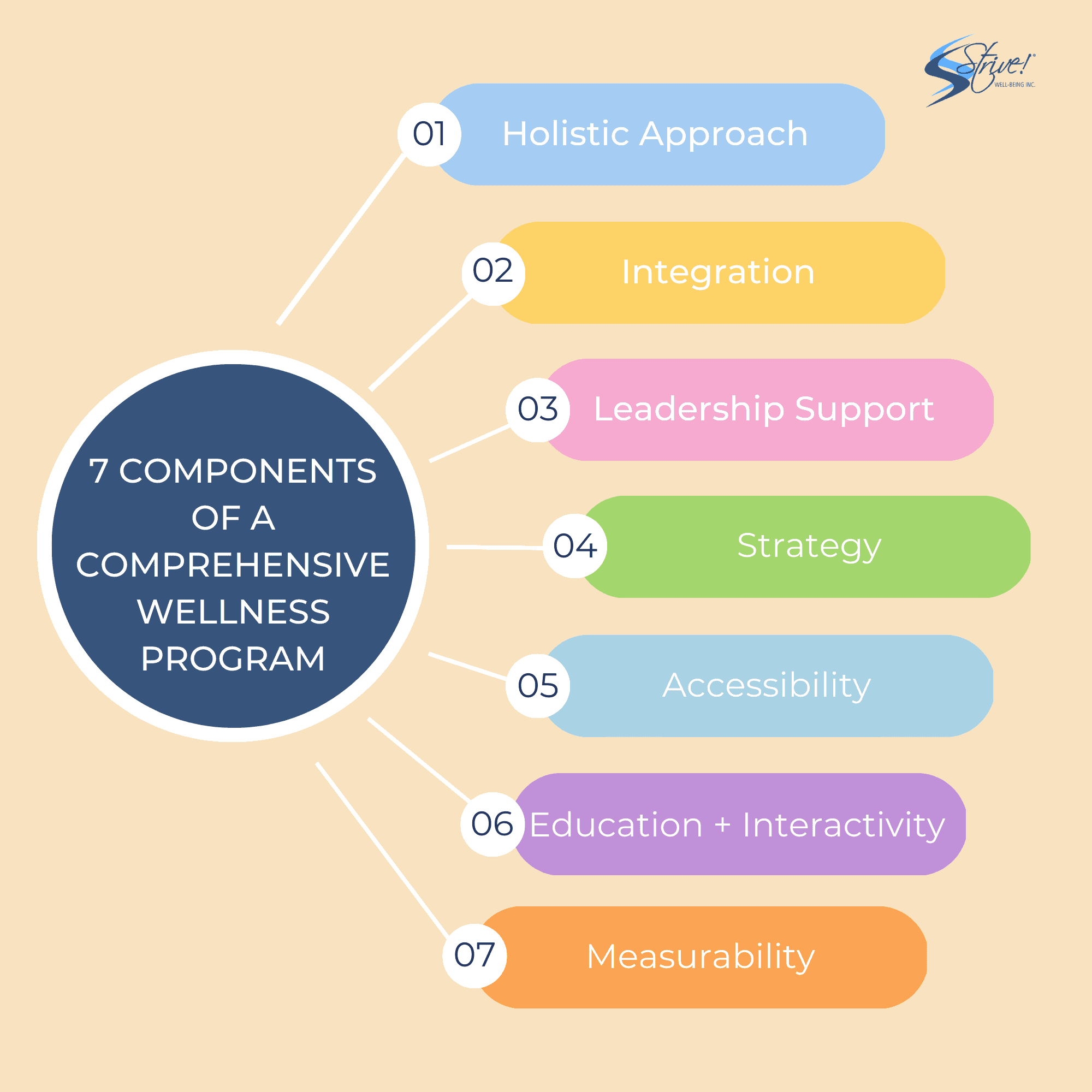Comprehensive Wellness Program Components
Business leaders are searching for new ways to drive employee engagement while optimizing their own health care spending. A well-designed comprehensive wellness program does just that by integrating individual health maintenance and promotion along with organizational strategies.
Comprehensive wellness programs are designed to help employees pursue total well-being by addressing all aspects of wellness, rather than focusing on one or two areas. This well-rounded approach lends itself to better employee engagement and a more effective wellness program. There are seven major components to a comprehensive wellness program that’s poised for maximum impact.
7 Components of Comprehensive Workplace Wellness Programs
In this post:
1. A Holistic Approach to Wellness
2. The Wellness Program is Integrated into the Organization’s Structure
3. Leadership Supports the Wellness Program
4. Time is Invested for Strategy & Implementation
5. The Programming is Easily Accessible for Employees
6. Programming Includes Awareness & Engagement
7. Comprehensive Wellness Programs are Measurable
8. Implementing a Comprehensive Wellness Program with Strive
A Holistic Approach to Wellness
While physical health is a vital aspect of wellness, comprehensive corporate wellness programs recognize the multifaceted nature of well-being. Addressing various dimensions ensures a holistic approach to employee health. Check out these eight pillars:
- Physical
- Care & maintenance of the body (diet, exercise, sleep)
- Social
- Connection & relationship with others
- Emotional
- Understanding, navigating, & communicating emotions (stress management)
- Nutritional
- Maintaining a balanced diet
- Financial
- Living within a person’s means/planning for the future
- Spiritual
- Connection to a person’s life purpose/higher power
- Intellectual
- Open to experiences/opportunities that stimulate the mind
- Environmental
- Work environment that promotes wellness/sustainable practices
A holistically-minded organization is challenged to identify creative solutions to produce programming that satisfies multiple dimensions of wellness. For example, a healthy cooking demo promotes nutritional and social well-being as colleagues learn how to prepare and enjoy a healthy meal while interacting with one another. Wellness vendors like Strive can help facilitate a program that not only addresses total well-being, but each component discussed in this post.
The Wellness Program is Integrated into the Organization’s Structure
The goals and objectives of the comprehensive wellness program help achieve the organization’s overall mission. It’s structured to strengthen company culture and is tailored to the specific health needs of the employees. The organization believes in creating wellness opportunities for its people.
A successful integration requires multi-level management support and commitment to the program’s implementation, followed by promoting the program’s benefits and activities at all levels of the organization. Policies and procedures are in place to protect employees’ time to pursue wellness initiatives and to feel safe in their working environment.
Leadership Supports the Wellness Program
Wellness culture begins at the top. Leadership support makes a significant impact on the ultimate success and sustainability of the wellness program. C-suite involvement sends a powerful message to employees about the value of their health and well-being.
It’s important for internal stakeholders pushing wellness initiatives forward to solidify leadership commitment to the corporate wellness program early on. Visible support is crucial — whether leaders serve as role models with their own wellness journey, or they simply send out communications from their email and attend events as their schedule allows.
Time is Invested for Strategy & Implementation
Especially in the planning and implementation phases of launching an employee wellness program, time is a valuable resource. Gathering insights on employees’ needs and interests, setting a budget, collaborating to choose wellness initiatives, and developing an ongoing engagement strategy are all aspects of ensuring the sustainability of the program. Once the wellness program is off the ground, time is still required for consistent communication and data collection and analysis to evaluate and evolve it to the changing needs of the workforce.
Organizations opt to work with a vendor like Strive to alleviate much of the initial lift and administrative burden of corporate wellness programs. Our team:
- Provides the employee needs and interests survey
- Consults on the design and budgetary restrictions
- Helps plan the programming with monthly/quarterly themes
- Provides marketing communications
- Reports on engagement data & makes programmatic recommendations
The Programming is Easily Accessible for Employees
In a world of competing priorities, convenience is key. For many employees, the most challenging aspect of pursuing fitness or well-being goals is showing up! Overcoming accessibility issues reinforces employee engagement and reduces frustration. Clear, consistent communication and intuitive programming allows employees to prioritize wellness initiatives in a busy schedule.
Organizations should also consider the composition of their workforce. Is it onsite or remote? Geographically dispersed? Varying time zones? It’s important to offer virtual options if it’s the more accessible option for the employee population at large.
Strive’s proprietary technology platform allows employees to sign liability waivers with the click of a button, seamlessly register for classes/events, and receive reminder notifications or virtual links to add to their calendar.
Programming Includes Awareness & Engagement
Comprehensive wellness programs combine foundational knowledge with practical application to equip employees with long-lasting healthy habits. Presenting employees with the necessary tools and skills to make informed decisions about their health and providing opportunities to engage in regular physical activity such as yoga or a fitness class, effectively promotes healthy lifestyle choices.
Strive leverages health talks as an awareness element and instructor-led classes for engagement. For example, the monthly theme is stress management. We’d provide a health talk on stress management techniques and weekly mindfulness meditation and Fitness Express classes.
Discover 3 Corporate Wellness Initiatives to Support a Healthy Workforce.
Comprehensive Wellness Programs are Measurable
Tracking the effectiveness of a wellness program is imperative not only for VOI (Value On Investment) but to identify areas needing improvement. Leveraging engagement data highlights opportunities as well as success metrics that can be discussed among stakeholders.
Analyzing the data can also reveal if the budget is being allocated appropriately. Are enough people being reached, or is there opportunity to expand? There can also be specific groups within a population, like those who smoke or are admittedly stressed, who would benefit from a specific class or coaching service.
Learn more about How-To Choose the Right Corporate Wellness Partners.

Benefits of Comprehensive Wellness Programs
Investing in workplace health strategies has real, measurable benefits for both employees and the organization. When thoughtfully designed and consistently implemented, wellness initiatives can improve workplace culture, support employee health, and drive organizational performance. Here are some of the key advantages:
Benefits Include:
- Enhanced Employee Engagement: Wellness programs can boost morale and foster a positive work environment.
- Reduced Healthcare Costs: Proactive wellness initiatives can lead to lower medical expenses for organizations.
- Improved Productivity: Healthy employees are often more focused and efficient.
- Attraction and Retention of Talent: Comprehensive wellness programs can make organizations more appealing to current and prospective employees.
Implementing a Comprehensive Wellness Program with Strive
Strive provides turnkey implementation of wellness programming. This looks like:
- Built-in account manager and/or sourced full-time wellness coordinator
- Marketing materials
- Registration portal simplifies managing signups/liability waivers/communications
- Onsite & virtual classes and events
- Monthly employee engagement data and programmatic recommendations
Our goal is to ensure the wellness program serves the needs and interests of the employees. By alleviating administrative responsibility and offering a wide variety of wellness options, Strive paves the way for organizations’ comprehensive wellness programs to succeed. Find out the 5 best employee wellness programs of the year or book a discovery call to explore the possibilities for your organization.



